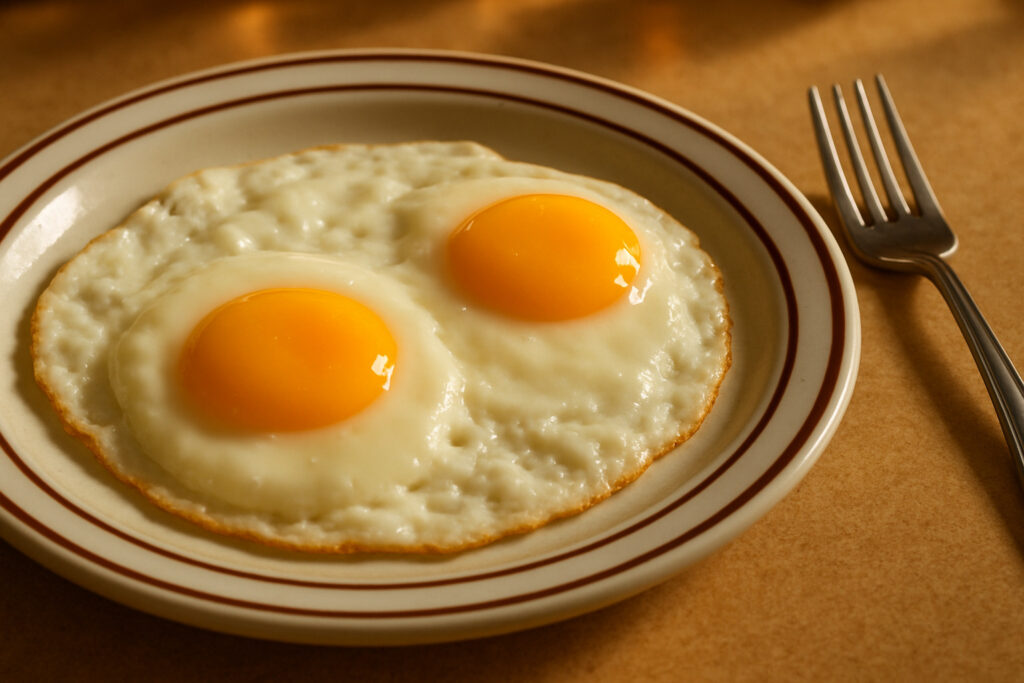Why Mastering Eggs Over Easy Transforms Your Breakfast Game
Eggs over easy are the perfect bridge between runny and set – giving you fully cooked whites with a golden, liquid yolk that creates its own built-in sauce. This classic diner technique takes just 3-4 minutes and requires only basic kitchen skills, yet many home cooks struggle with the flip.
Quick Answer: Eggs Over Easy Basics
- What they are: Eggs flipped and cooked briefly on both sides with runny yolks
- Cook time: 2-3 minutes first side, 15-30 seconds after flipping
- Key difference: Unlike sunny-side up (never flipped), over easy eggs cook on both sides
- Perfect texture: Fully set, opaque whites with liquid golden yolk center
As one cooking expert noted: “You know, there’s something about perfect over easy eggs that just hits the spot. Not to mention how quick and simple this over-easy eggs recipe truly is!”
The technique seems simple – crack, cook, flip, done. But getting that perfect flip without breaking the yolk takes practice. The reward? A versatile protein that works on everything from buttered toast to rice bowls to gourmet burgers.
Whether you’re recreating that perfect diner breakfast at home or adding restaurant flair to your morning routine, mastering eggs over easy opens up endless possibilities for quick, satisfying meals.
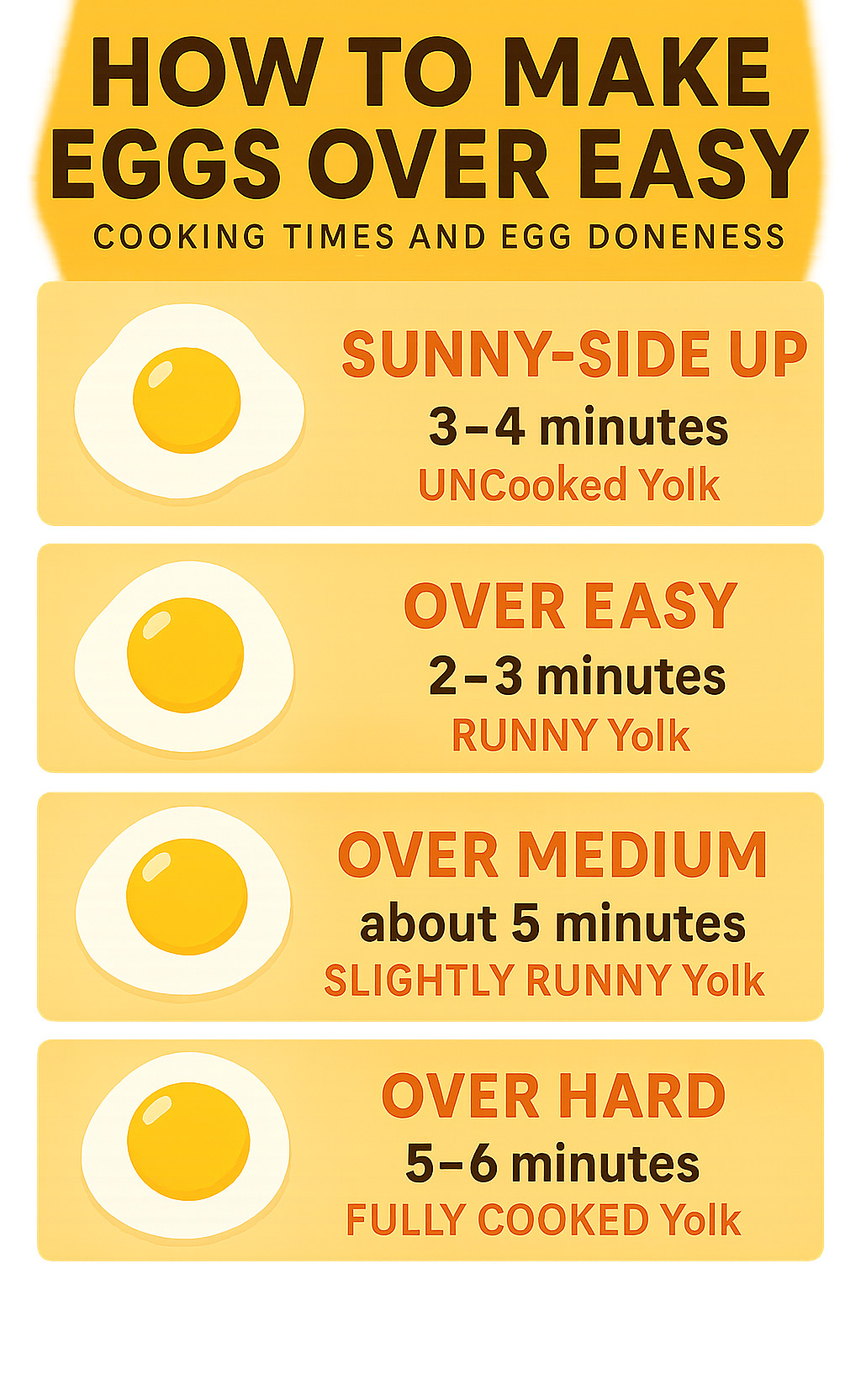
Eggs over easy terms made easy:
What Are Eggs Over Easy?
Think of eggs over easy as the perfect compromise in the fried egg world. They’re flipped once and cooked just long enough on the second side to set the whites completely, while keeping that gorgeous golden yolk nice and runny. The “easy” part? That’s diner speak for the gentle touch – just 15-30 seconds after the flip before they’re ready to serve.
The magic happens in that quick flip. Unlike sunny-side up eggs that never leave their original position, eggs over easy get turned over to cook both sides. This creates fully opaque, tender whites while preserving that liquid gold center that makes toast so much better.
Here’s how the four main fried egg styles stack up:
| Style | Flipped? | Cook Time After Flip | Yolk Texture | White Texture |
|---|---|---|---|---|
| Sunny Side Up | No | N/A | Runny | Set bottom, slightly soft top |
| Over Easy | Yes | 15-30 seconds | Runny | Fully set both sides |
| Over Medium | Yes | 30-45 seconds | Jammy/soft | Fully set both sides |
| Over Hard | Yes | 1-2 minutes | Fully cooked | Fully set both sides |
The beauty of eggs over easy lies in that perfect balance – you get the food safety of fully cooked whites without sacrificing the rich, creamy yolk that turns any dish into something special.
History & Culinary Context of Eggs Over Easy
Eggs over easy have their roots deep in American diner culture, where busy short-order cooks needed a quick way to communicate exactly how customers wanted their eggs. No long explanations needed – just “over easy” and everyone knew what that meant.
In the busy diners of New York City, this style became the breakfast of choice for people who wanted something more refined than scrambled but less risky than sunny-side up. It represented the perfect middle ground – sophisticated enough for a business breakfast, comforting enough for a weekend brunch.
The technique spread from professional kitchens to home cooks who wanted to recreate that authentic diner experience in their own kitchens. Today, eggs over easy have evolved far beyond traditional breakfast plates, showing up on everything from gourmet burgers to grain bowls to late-night comfort food.
What started as practical diner lingo has become a symbol of culinary skill – proof that sometimes the simplest techniques require the most finesse to get just right. For more information about the cultural significance of eggs in American cuisine, you can explore the history of eggs in cooking and their role in shaping breakfast traditions.
Ingredients & Equipment Checklist
Making perfect eggs over easy starts with gathering the right ingredients and tools. The good news? You probably already have everything you need in your kitchen.
Fresh eggs are your foundation – look for large eggs with bright orange yolks if possible. Farm-fresh eggs have stronger whites that hold together better during the flip, but regular grocery store eggs work beautifully too.
For cooking fat, unsalted butter creates that classic diner flavor with gorgeous golden edges. You’ll need about a tablespoon per two eggs. Keep your seasoning simple with kosher salt and freshly ground black pepper – that’s it.
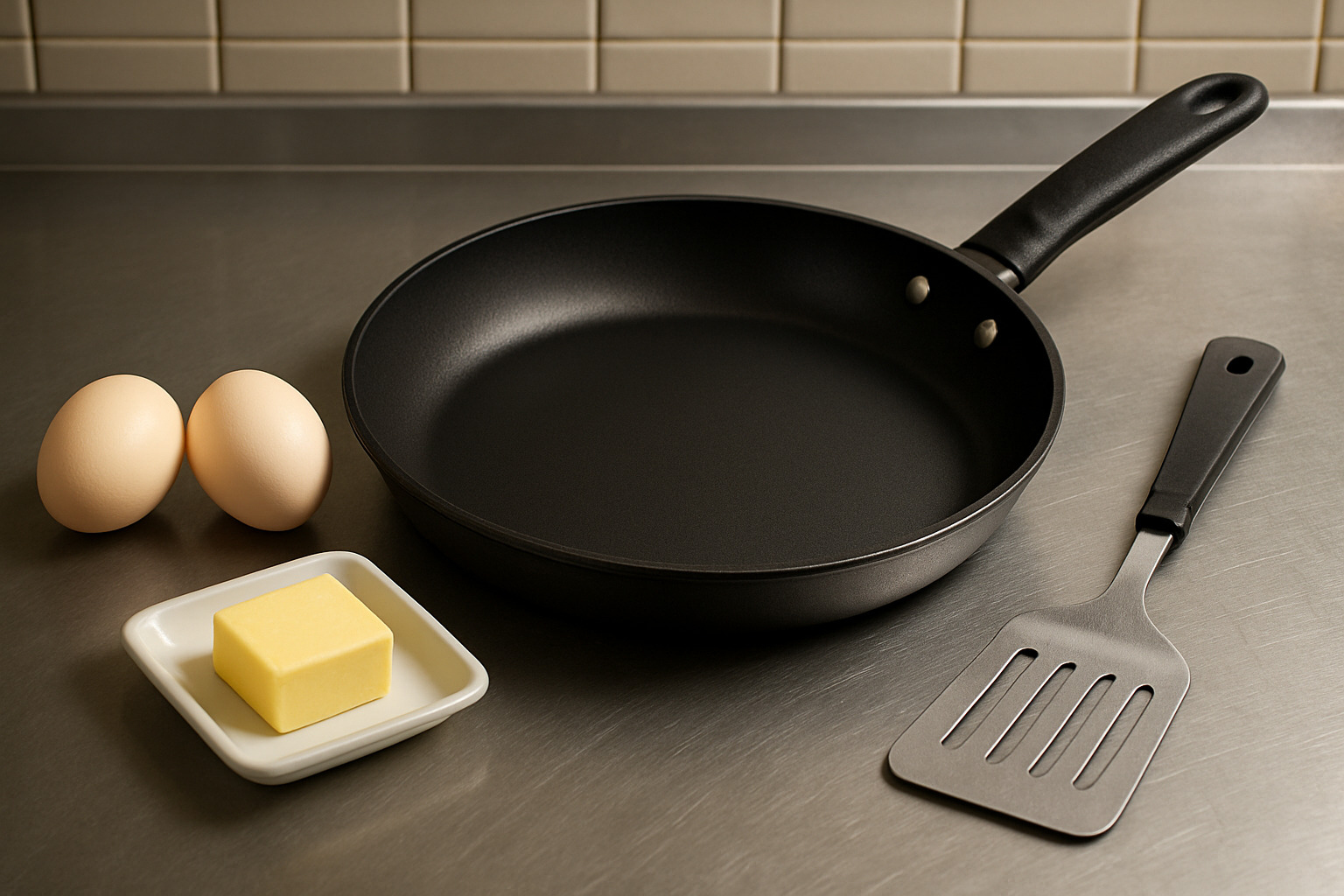
Equipment-wise, your pan choice makes all the difference. An 8-inch nonstick skillet is your best friend here – it’s the perfect size for two eggs and requires minimal fat. If you’re a cast iron enthusiast, a well-seasoned pan creates incredible crispy edges and superior heat retention.
Your spatula is crucial – grab a thin, flexible one that’s wide enough to slide under the entire egg. Those thick, chunky spatulas will break your yolk every time. Trust me on this one.
A small bowl for cracking eggs isn’t essential, but it’s a game-changer. You can check for broken yolks before they hit the pan, and it makes the whole process smoother. Some cooks swear by having a kitchen thermometer handy, but once you get the feel for the right heat, you won’t need it.
For more detailed guidance on choosing the perfect cookware, check out our comprehensive pan guide.
Can You Swap Butter for Oil When Frying Eggs Over Easy?
Absolutely! While butter delivers that rich, nutty flavor that makes diner-style eggs over easy so irresistible, oil has its own advantages that might surprise you.
Butter creates beautiful browning and adds incredible flavor, but it has a lower smoke point. This means you need to be more careful with your heat – too hot and the butter burns before your eggs are done.
Oil gives you more flexibility with temperature and creates wonderfully crispy edges. Olive oil adds a Mediterranean touch, while avocado oil handles high heat like a champ. Vegetable oil keeps things neutral, letting the egg flavor shine through.
The cooking technique stays exactly the same regardless of your choice. Use enough fat to prevent sticking – about a tablespoon for two eggs – but not so much that your eggs swim in grease. Whether you choose butter or oil, you’ll still get that perfect runny yolk that makes eggs over easy such a breakfast favorite.
Step-by-Step: How to Make Perfect Eggs Over Easy
The secret to perfect eggs over easy isn’t complicated – it’s all about gentle heat, proper timing, and building confidence for that crucial flip. Once you nail this technique, you’ll be making restaurant-quality eggs in your own kitchen every morning.
Start by getting everything ready before you even turn on the heat. Crack your eggs into a small bowl first – this prevents any surprise broken yolks from ruining your pan, and makes pouring much smoother. Have your spatula within arm’s reach and your salt and pepper ready to go.
Heat control makes all the difference. Set your skillet over medium-low heat and add your butter. You want the butter to melt and foam gently, but not turn brown – that’s your signal that the temperature is just right. Give the pan a little swirl to coat the bottom evenly.
Now comes the gentle pour. Tip those eggs from your bowl right into the center of the pan, then immediately tilt the skillet slightly to let the whites pool in one corner for about 10-15 seconds. This little trick helps the whites cook more evenly. Level the pan back out and give the eggs a light sprinkle of salt.
Here’s where patience pays off. Let those eggs cook undisturbed for about 1½ to 2 minutes. You’ll watch the magic happen as the whites turn from clear to opaque, starting from the edges and working inward. You’re ready for the flip when only a small ring of clear white remains around the yolk.
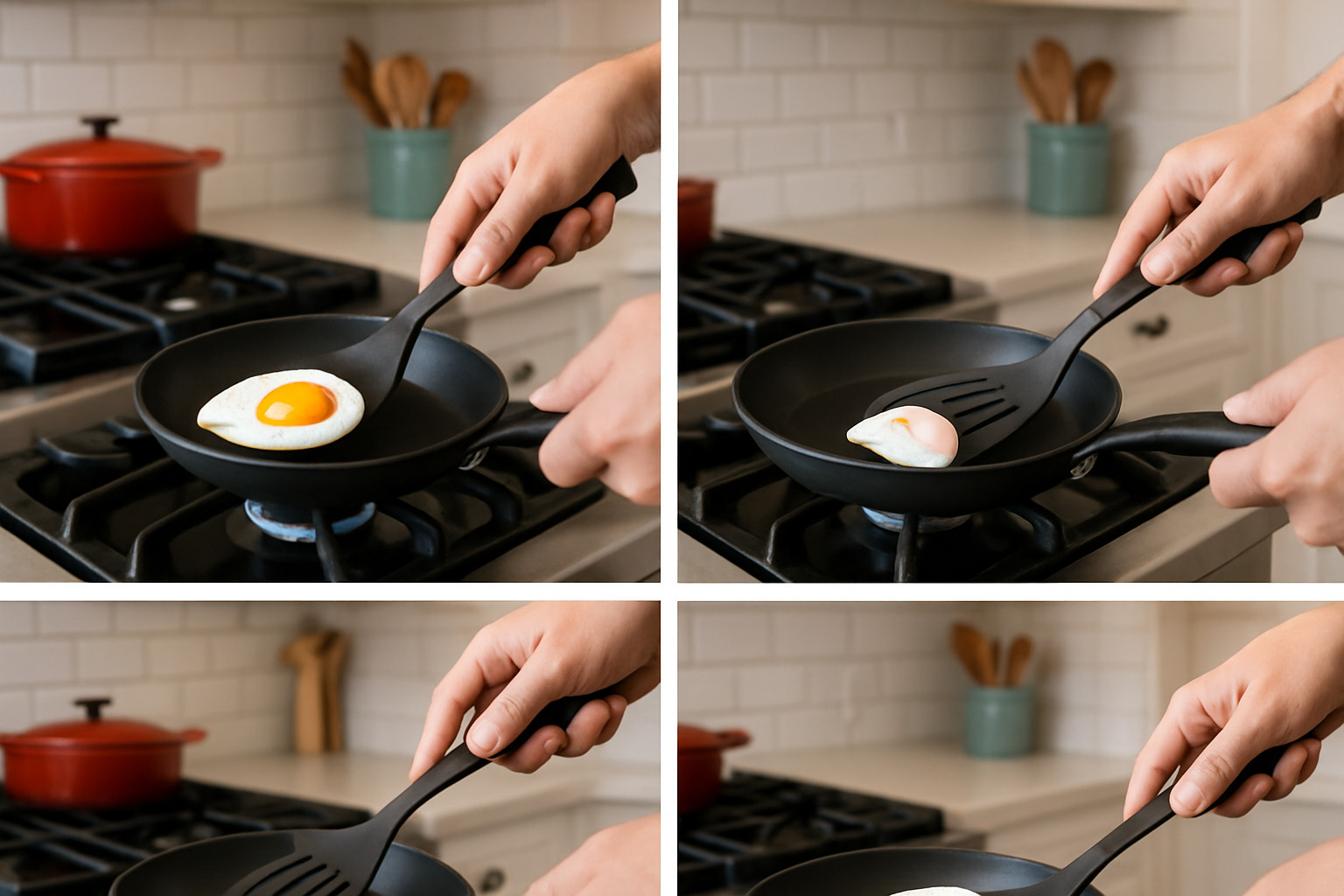
The flip is your moment to shine. Slide your spatula completely under the egg, making sure it’s centered under that precious yolk. Take a breath, then flip with one smooth, confident motion away from your body. Don’t hesitate – confidence is key! Once flipped, count to 20 (or wait 15-30 seconds) for that perfect runny yolk.
Finish with a crack of fresh black pepper and slide your eggs over easy onto a warm plate. The timing matters here – serve immediately while that golden yolk is still liquid and ready to create its own delicious sauce.
Visual Cues for Flipping Eggs Over Easy
Forget watching the clock – your eyes will tell you exactly when those eggs over easy are ready for their big flip. Learning to read these visual signs will make you a more intuitive cook.
The whites are your best indicator. They should be completely opaque with no jelly-like clear spots remaining. You’ll notice the edges have firmed up and might even have a slight golden tinge if you’re using butter. When you gently shake the pan, the whole egg should move as one piece rather than having wobbly, unset areas.
Look for that magic ½-inch border around the yolk where the whites are just barely soft but not runny. This is your sweet spot – wait much longer and you’ll have tougher whites, flip too early and you’ll have a mess.
The gentle shake test works every time. Give your pan a little jiggle – if the egg slides around freely, you’re good to go. If it sticks or parts of it lag behind, give it another 30 seconds.
Best Tips for Flipping Eggs Over Easy Without Breaking the Yolk
Let’s be honest – the flip is where most people panic when making eggs over easy. But with the right technique, you’ll nail it every single time.
Your spatula choice matters more than you think. Use a thin, flexible spatula that’s wide enough to support the entire egg. Those thick, clunky spatulas just don’t give you the control you need. Slide it completely under the egg, making sure you’ve got the yolk centered on your spatula.
Here’s the technique that changes everything: Instead of just flipping your wrist, push the pan slightly away from you first, then snap the far edge upward in one smooth motion. Think of it like closing a book – confident and deliberate, not hesitant.
The pan-lifting trick is pure genius. As the egg comes down from the flip, lift your pan slightly to meet it rather than letting it drop and potentially splatter. This gentle landing keeps everything intact.
If you’re still nervous about flipping, try the steam-baste method instead. Once your whites are nearly set, add a tablespoon or two of water to the pan and immediately cover with a lid. The steam will gently cook the top without any flipping required – you’ll still get that perfect runny yolk with fully cooked whites.
The key is practicing with confidence. Every broken yolk teaches you something, and before you know it, you’ll be flipping eggs over easy like a pro.
Pro Tips, Variations & Common Mistakes
The difference between restaurant-quality eggs over easy and disappointing home attempts often comes down to small details that professional cooks know by heart. After years of watching both expert chefs and home cooks tackle this seemingly simple dish, certain patterns emerge that separate success from soggy disappointment.
Temperature control is your secret weapon. Many home cooks crank the heat thinking it’ll speed things up, but high heat is the enemy of perfect eggs. Your pan should be warm enough that butter sizzles gently but doesn’t immediately turn brown. If you hear aggressive sizzling when the eggs hit the pan, you’ve gone too far.
The cold egg trap catches many people off guard. Eggs straight from the fridge are more likely to stick and cook unevenly. Let them sit on your counter for 15 minutes before cooking – this small step makes a huge difference in how smoothly everything goes.
Overcrowding your pan is another rookie mistake. Even if you’re cooking for the family, resist the urge to crack four eggs into one pan. Two eggs maximum per 8-inch skillet gives you the control you need for perfect flips.
Your spatula choice matters more than you might think. That thick pancake flipper sitting in your drawer? Leave it there. You need something thin and flexible that can slide under the delicate whites without tearing them. The spatula should be wide enough to support the entire egg during the flip.
When you’re ready to level up your technique, try the two-spatula method that professional cooks use. Use your main spatula to lift the egg while using a second one to gently guide it through the flip. It feels awkward at first but gives you incredible control.
For batch cooking when you have guests, use a larger 12-inch pan and work systematically. Cook all eggs to the first-side-done stage, then flip them in the same order you started. This keeps timing consistent across all servings.
The steam-baste alternative works beautifully if flipping makes you nervous. Once your whites are nearly set, add a tablespoon of water to the pan and immediately cover with a lid. The steam gently cooks the top surface while keeping that yolk perfectly runny.
Flavor variations can transform your basic eggs over easy into something special. Fresh chives sprinkled after flipping add a delicate onion note. Smoked paprika brings warmth and depth. Everything bagel seasoning gives you that trendy brunch-spot flavor at home.
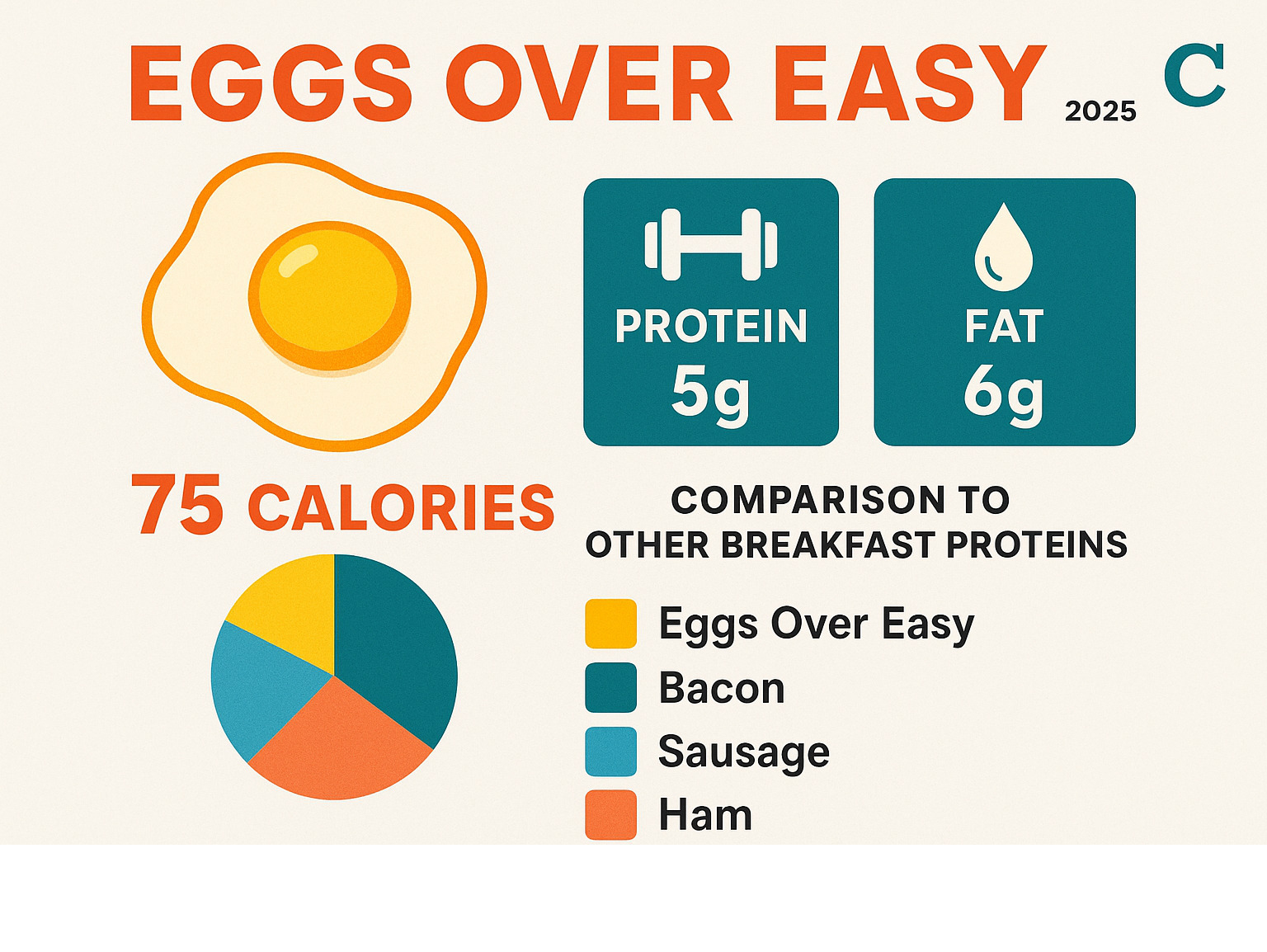
Serving Ideas Beyond Breakfast
That golden, runny yolk in eggs over easy is nature’s perfect sauce – and it’s criminally underused outside of morning meals. The moment that yolk breaks and flows, it transforms whatever it touches into something richer and more satisfying.
Burger lovers finded this secret years ago. A perfectly cooked egg on top of a burger creates an instant sauce that beats any bottled condiment. The yolk mixes with the meat juices and creates something magical that you can’t get any other way.
Grain bowls become complete meals when you crown them with eggs over easy. Whether you’re working with quinoa, rice, or farro, that broken yolk ties all the separate elements together. Add some roasted vegetables and you’ve got a dinner that feels both healthy and indulgent.
Salad skeptics often change their tune when warm eggs over easy hit cold greens. The temperature contrast wakes up your palate, while the yolk creates a creamy dressing that makes even simple lettuce feel luxurious.
Pizza night gets an upgrade when you crack eggs over your pie during the last few minutes of baking. The whites set in the oven heat while the yolk stays creamy – it’s a technique that turns regular pizza into brunch-worthy fare.
Pasta enthusiasts can create instant carbonara-style dishes by tossing hot noodles with broken egg yolks, cheese, and black pepper. It’s faster than making a traditional sauce and just as satisfying.
The global influence of eggs over easy spans continents. Korean bibimbap traditionally features this style of egg as the crowning element. French croque madame wouldn’t be the same without it. Mexican huevos rancheros rely on that runny yolk to bind with the salsa and tortillas.
For more creative ways to use eggs beyond breakfast, check out our collection of easy dinner ideas that’ll expand your evening cooking repertoire.
Nutrition Facts & Dietary Notes
Eggs over easy pack serious nutritional punch into a small, affordable package. Each large egg cooked with half a tablespoon of butter delivers 122 calories with an impressive 6 grams of complete protein – meaning it contains all the essential amino acids your body needs.
The 11 grams of fat might seem high, but it’s mostly the good kind that keeps you satisfied. With zero carbohydrates, these eggs fit perfectly into low-carb and ketogenic lifestyles that many people follow today.
The cholesterol content of 201mg per egg used to scare people away, but modern nutrition science tells a different story. Research shows that dietary cholesterol has less impact on blood cholesterol than we once thought. The protein quality is exceptional – eggs are considered the gold standard that other proteins are measured against.
Dietary compatibility makes eggs incredibly versatile. They’re naturally gluten-free, perfect for vegetarians seeking quality protein, and ideal for paleo followers. The keto-friendly profile – high fat, zero carbs – makes them a staple in many modern eating plans.
Vitamin and mineral content includes vitamin D, vitamin B12, and selenium. The yolk contains lutein and zeaxanthin, antioxidants that support eye health. When you consider the complete nutritional package, eggs over easy offer remarkable value for both your wallet and your health.
The satiety factor shouldn’t be overlooked either. That combination of protein and fat keeps you feeling full much longer than carb-heavy breakfast options. Two eggs over easy can power you through a busy morning without the energy crash that comes from sugary breakfast foods.
Frequently Asked Questions about Eggs Over Easy
What’s the ideal texture for eggs over easy?
Picture this: you cut into your eggs over easy and that golden yolk flows out like liquid sunshine, coating your toast in rich, creamy perfection. That’s exactly what you’re aiming for – a yolk that’s completely liquid but has just enough body to create an instant sauce.
The whites should be your foundation – completely set and opaque with no jelly-like patches hiding anywhere. They should feel tender when you bite into them, never rubbery or tough. If you’re getting chewy whites, you’re cooking too hot and fast. Those slightly golden edges? Perfect. Dark brown and crispy? You’ve gone too far.
When done right, the contrast is beautiful – firm, silky whites supporting that liquid gold center that transforms whatever it touches into something special.
How do I cook eggs over easy for a crowd?
Cooking eggs over easy for your family or weekend guests doesn’t have to stress you out. The secret is having the right game plan and not trying to be a hero with too many eggs at once.
Your best friend here is a large 12-inch nonstick skillet – it gives you room to work without crowding. You can comfortably handle 4 eggs at once if you stay organized. Any more than that and you’re asking for trouble with timing and flipping.
Here’s the strategy that works: crack all your eggs into separate small bowls first. This lets you add them to the pan quickly and in the exact order you want. When it’s time to flip, work in the same sequence – first egg in, first egg flipped. This keeps your timing consistent.
If you’re feeding a bigger crowd, use two 8-inch pans simultaneously rather than cramming everything into one giant pan. Your guests will appreciate eggs that are actually cooked properly instead of half-raw disasters.
Keep those plates warm in a 200°F oven, and remember – eggs over easy are meant to be served immediately. They don’t like waiting around.
Can I store and reheat eggs over easy safely?
Let’s be honest – eggs over easy are really meant to be enjoyed hot off the pan. That runny yolk is the whole point, and once it cools down, the magic starts to fade.
But life happens, and sometimes you have leftovers. You can safely store them in the fridge for up to a day in an airtight container, but here’s the thing – when you reheat them, that beautiful runny yolk is going to set up more. You’ll essentially end up with over-medium or even over-hard eggs.
If you do need to reheat, gentle is the key word. Try 15-20 seconds in the microwave at 50% power, or warm them in a buttered skillet over low heat for about 30 seconds. The oven works too – just 2-3 minutes at 300°F.
The real advice? Cook fresh eggs when you can. Those extra 3-4 minutes of cooking time are totally worth it for that perfect runny yolk experience. Your taste buds will thank you, and you’ll remember why mastering this simple technique is so rewarding.
Conclusion
Mastering eggs over easy transforms your cooking confidence and opens up countless meal possibilities. This simple technique – requiring just fresh eggs, butter, proper heat control, and a confident flip – delivers restaurant-quality results in your own kitchen.
Remember the key principles: medium-low heat for gentle cooking, patience during the first side, and confidence during the flip. The visual cues matter more than exact timing – look for opaque whites and that crucial moment when the egg moves freely in the pan.
Whether you’re creating the perfect weekend brunch, adding protein to a grain bowl, or elevating a simple burger, eggs over easy provide that luxurious runny yolk that acts as nature’s perfect sauce.
The beauty of this technique lies in its versatility and simplicity. Once you’ve mastered the basic method, experiment with different serving styles and flavor combinations. Try pairing your perfect eggs over easy with our waffle recipe for the ultimate brunch experience.
At The Dining Destination, we believe that mastering fundamental techniques like eggs over easy opens doors to culinary trips around the world. From New York City’s classic diners to international breakfast traditions, these skills connect us to food cultures everywhere.
Start practicing today – your breakfast game will never be the same. And remember, even if the yolk breaks occasionally, as one chef wisely noted: “act like you meant it” – they’ll still taste incredible.

